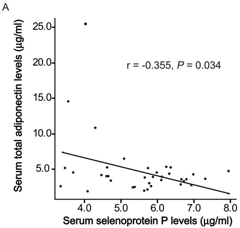- Home
- Highlights
- Finding the proteins involved in type 2 diabetes
Highlights
Finding the proteins involved in type 2 diabetes
Researchers in Japan have found a correlation between the overproduction of a protein secreted by the liver and low levels of glucose regulation in type 2 diabetes patients.
Toshinari Takamura of Kanazawa University led a team of researchers from across Japan to study the newly discovered selenoprotein P (SeP) and how it acts on body fat tissues.
SeP is produced by the liver, and is known to cause insulin resistance in both the liver itself and skeletal muscle. It is therefore a key protein in patients with type 2 diabetes. Takamura and co-workers hypothesized that SeP acts on fat cells (adipocytes) and subsequently affects the production of adiponectin – the protein secreted by fat cells which helps to regulate glucose levels in the body. Low levels of adiponectin (hypoadiponectinemia) can lead to glucose intolerance and thickening of the artery walls.
The researchers compared blood SeP levels with adiponectin levels in type 2 diabetes patients. Statistical analysis showed an inverse correlation between SeP and adiponectin. The measurements of SeP in a patient’s blood can therefore be used as a predictor for adiponectin levels.
The team also carried out experiments on SeP knockout mice, to further analyse the protein’s effect under different dietary conditions. The mice without SeP proteins showed no hypoadiponectinemia, even when they were on a high fat and sugar diet.
Takamura and co-workers admit that the effect of SeP is only partial, and there are other factors which contribute to hypoadiponectinemia. The team hope to continue their work in understanding SeP, its effects on body fat tissues, and its contribution to type 2 diabetes.
Publication and Affiliation
Hirofumi Misu1, Kazuhide Ishikura1, Seiichiro Kurita1, Yumie Takeshita1, Tsuguhito Ota1, Yoshiro Saito2, Kazuhiko Takahashi3, Shuichi Kaneko1, & Toshinari Takamura1,* Inverse Correlation between Serum Levels of Selenoprotein P and Adiponectin in Patients with Type 2 Diabetes. PLOS one 7(4) (2012).Link
1. Department of Disease Control and Homeostasis, Kanazawa University Graduate School of Medical Science, Kanazawa, Ishikawa, Japan
2. Department of Medical Life Systems, Faculty of Medical and Life Sciences, Doshisha University, Kyotanabe, Kyoto, Japan
3. Department of Nutritional Biochemistry, Hokkaido Pharmaceutical University, Otaru, Hokkaido, Japan
*corresponding author, e-mail address: ttakamura@m-kanazawa.jp
ID: 201212B004

